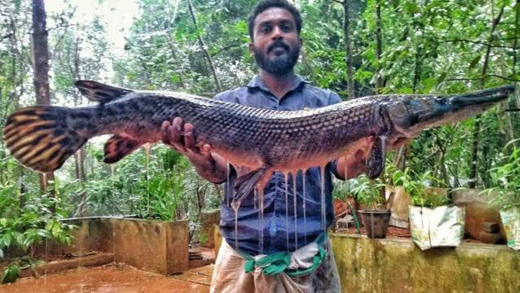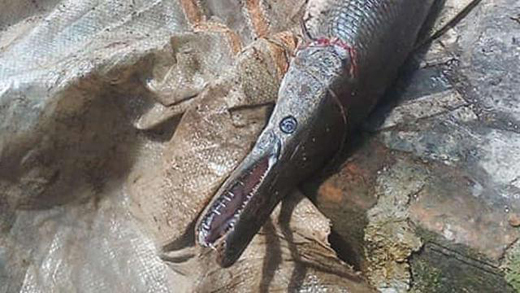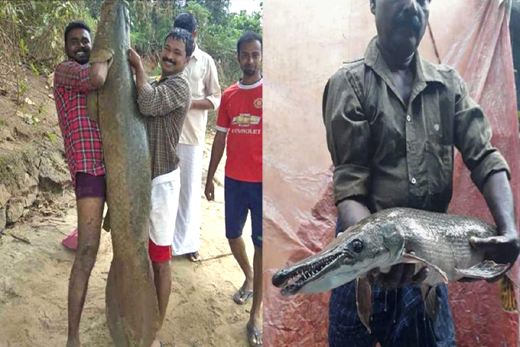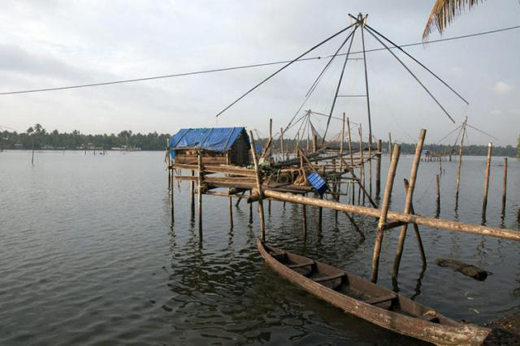Monstrous alien fish spotted in the rivers of Kerala after the state’s floods
Monstrous alien fish spotted in the rivers of Kerala after the state’s floods
Mangloretoday.com/ yahoo news
It was 7 September, barely a month after the floods of 2018 had wrecked large parts of Kerala. Though life was far from normal in Thrissur’s coastal Kodungalloor, 48-year-old Jaison Kallarackal was at his Chinese fishing net at dusk to land the day’s catch. As he began to haul the net up, he realised that it was unusually heavy; something large was wriggling in the net, causing it to shake. When a final heave raised the net slightly above water, Kallarackal could not believe his eyes.
Squirming around at the base was a fish he had never seen before: flat-headed and sporting large scales tinted in pink and cream. It measured six feet long and weighed a whopping 41 kilograms.
WhatsApp photographs of the unusual fish brought Smrithy Raj, a doctoral researcher studying fishes at Thiruvananthapuram’s >University of Kerala, to the spot in a couple of days. But all he saw of the fish was its severed head: it had already been sold in the market. His journey, however, was not in vain; he was able to procure a small piece of fish tissue from the head. Genetic tests revealed that it was the arapaima, one of the world’s largest freshwater fish, endemic to the Amazon in South America.

A man displays an alligator gar caught from a river in Kerala. The fish can measure up to three metres in length and could put the native fish species at risk. Image credit: Smrithy Raj.
After a month’s such work of analysing news reports, social media photographs and videos of ’strange’ fish caught after the 2018 floods, and re-confirming sightings with local fishermen and fish vendors, the team €" of A. Biju Kumar (University of Kerala), Raj, C.P. Arjun (of Thiruvananthapuram’s >Indian Institute of Information Technology and Management) and Unmesh Katwate and Rajeev Raghavan (of Kochi’s >Kerala University of Fisheries and Ocean Studies €" KUFOS) €" also obtained information on the presence of the alligator gar, another fish never recorded in Kerala’s waters before. Like the arapaima, the gar too is alien: its native habitats are the freshwater lakes of North America.
These post-flood field surveys revealed that fishers had caught arapaima and gar from four flood-affected rivers in Kerala: the Periyar, Muvattupuzha, Kurumali and Chalakkudy. The presence of these alien fish €" which are being farmed illegally in the state €" could bode ill for Kerala’s native fish diversity, claim the scientists. In their >communication in the journal Current Science in May this year, the team call for an urgent nationwide scheme to eradicate such alien fish species.

Kerala’s flood ’fugitives’
Kerala’s river systems, which the authors study, are home to around 200 species of fish, 30 percent of which are endemic to the region. But this diversity is at risk due to ’fugitive’ fish such as the arapaima and gar that escaped from aquaculture facilities and farms during the floods, claim the authors. Calling the 2018 floods one of the most "significant threats" to Kerala’s fish diversity, the team adds that the presence of alien arapaima (Arapaima gigas) and alligator gar (Atractosteus spatula) here is a serious concern for several reasons.

Both alien species can grow to be enormous. While alligator gar can measure up to three metres in length, arapaima is five metres long and weigh up to a whopping 200 kg. Both species are also top predators in their native habitats, feeding on smaller fish (which puts Kerala’s small native species at risk). The arapaima and gar are dedicated parents too: their active care of their young increases the survival of their broods.
Additionally, arapaimas are air-breathers, a feature that could help them survive even in polluted habitats. Their large scales are tough for predators to break through. Arapaima introductions in some American countries have caused a decline in native species, which in turn has affected local fisher livelihoods. Alligator gar too are formidable predators; they are piscivorous generalists with an affinity towards live fish, said Raghavan, an assistant professor at KUFOS. "This species could have a bigger chance to proliferate in Kerala’s freshwater habitats than the arapaima," he says.

Are fugitives always foes?
However, there are no studies on the actual impacts these species could have on freshwater systems in India. And the team recorded only six arapaima and gar in total: a number that seems barely enough to ’threaten’ river systems.
The Chinese fishing net in Kodungalloor, Kerala, where Jaison Kallarackal caught the arapaima. The fish probably escaped from aquaculture facilities during the floods, and are now ’fugitives’ in the natural ecosystem, claim researchers. Image credit: Smrithy Raj.
Other invasives include the guppy and mosquitofish (legally introduced to control mosquito populations). ’Tankbusters’ €" fish that are capable of outgrowing most domestic aquaria €" are a problem too. Kumar, who documented how ornamental exotic South American suckermouth armoured catfishes (genus Pterygoplichthys) were invading the drain networks of Thiruvananthapuram city in a study in 2015, found that traders and aquarium hobbyists were releasing these fish into drains when they grew too large for their aquariums or tanks.
Similarly, there is a huge demand for arapaima and alligator gar among fish hobbyists but these fish quickly outgrow their aquariums and owners often release these fish in the wild, said Raghavan.
- Sullia: Mother, three-year-old daughter found dead in Kodiayala pond
- Mangaluru: Flower show at Kadri Park from January 23
- Belthangady: Man arrested with 55.48 g of MDMA; drugs worth Rs 5.54 lakh seized
- KSRTC Mangaluru–Udupi–Bengaluru bus fares reduced by 15%; effective from January 5
- Two Interstate Drug Peddlers Arrested in Bajpe; Ganja Seized
- Agumbe Ghat Hairpin Roads to Be Repaired Within a Week
- Provocative Social Media Posts on Narlapadavu Incident: Bajpe Police Book Case
- Udupi: Car Collides with Van van carrying Ayyappa devotees Parkala Junction; One Injured
- Belthangady Court Seeks Final SIT Report in Dharmasthala Mass Burials Case
- Diksha Ramakrishna Sets World Record in Six-Hour Gana–Nartana Performance
- Lamina pays rich tribute to visionary leader Vinay Hegde
- Karnataka launches Integrated Command and Control Centre to curb rising man–animal conflict
- Mangaluru: Two arrested with 21.45 kg of ganja smuggled from Odisha for New Year sale
- Karnataka headmaster spends own savings for students first flight, wins internet’s love
- NORAD’s Santa tracker turns 70: How does Santa visit every country in just 24 hours?
- Video: Dubai Crown Prince shares dramatic moment lightning strikes Burj Khalifa
- No leave, rings on screen: Karnataka Bride engaged to Canada-based groom online
- Train stationmaster Cat ’Nitama’ dies in Japan, more than 500 attend funeral
- When a man arranged item dance for villagers as son cracked NEET: Papa backbencher rahe honge
- 75 years of the Indian Rupee: From Sher Shah Suri to today; a 500-year global journey
- IndiGo flight cancelled, techie couple attends own reception online
- Man outsmarts scammer using ChatGPT, viral post shows fraudster begging for mercy
- Love lives: Woman marries lover’s body after family kills him over caste
- Watch: Grandmother, 75, impresses social media with stunning dance moves and a flip
- HR88B8888 becomes India’s costliest car registration number at Rs 1.17 crore
- Mumbai Shocker: Kaali Mata idol dressed like Mother Mary; priest claims goddess instructed him
- Indore water contamination: 142 patients in hospitals; 20 new diarrhoea cases found
- Karnataka busts Rs 1,464-crore interstate fake invoicing racket
- India Expresses Concern Over Venezuela Developments After US Captures President Maduro
- 13 years old girl Gang-Raped By 3 Minors Hubballi
- Karnataka headmaster spends own savings for students first flight, wins internet’s love
- BCCI asks KKR to release Mustafizur Rahman as India-Bangladesh tensions soar
- Degrees without dharma...: White-collar terrorism an alarming trend, Rajnath Singh warns
- 14 naxals killed in two separate encounters in Chhattisgarh’s Sukma, Bijapur
- Understanding Sangh by looking at BJP is huge mistake: RSS chief Mohan Bhagwat
- Sri Lankan navy arrests 11 Indian fishermen, seizes trawler
- Engineer, autorickshaw driver arrested for derogatory posts on actor Darshan’s wife
- Indore water contamination: Mayor confirms 10 deaths; over 270 hospitalised
- CITY INFORMATION
- TRAVEL
- TOURIST INFORMATION
- HEALTH CARE
- MISCELLANEOUS


 Write Comment
Write Comment E-Mail
E-Mail Facebook
Facebook Twitter
Twitter  Print
Print 